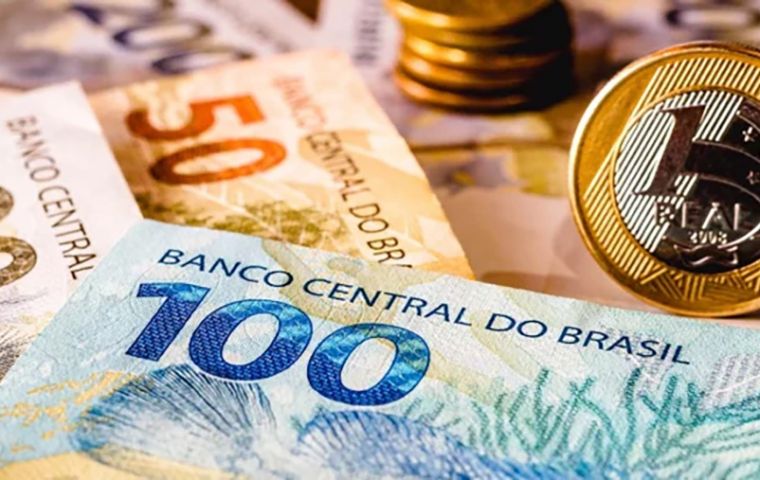MercoPress. South Atlantic News Agency
BCB ups Selic rate to 14.75% per annum
 It was the sixth Selic rate hike in a row
It was the sixth Selic rate hike in a row Brazil's Central Bank's (BCB) Monetary Policy Committee (Copom) unanimously decided Wednesday to raise the Selic benchmark rate by 0.5 percentage points to 14.75% per year, consolidating a contraction cycle. This decision was driven by high food and energy prices and global economic uncertainties, and the financial markets were expecting the move.
It was the sixth Selic rate hike in a row. The rate is at the highest level since August 2006, when it was also at 14.75% per year.
In a press release, Copom gave no clues as to what will happen at the next meeting in mid-June. It only affirmed that the climate of uncertainty remains high and will demand prudence from the monetary authority, both in eventual future increases and in the period in which the Selic must remain at 14.75% per year.
“For the next meeting, the high uncertainty scenario, together with the advanced stage of the adjustment cycle and its accumulated impacts yet to be observed, demands additional caution in the monetary policy action and flexibility to incorporate the data that impact the inflation dynamics,” the text highlighted.
After reaching 10.5% a year from June to August last year, the rate began to go up in September by 0.25 percentage points, then by 0.5 percentage points, and three times by 1 percentage point.
The Selic is the Central Bank's main instrument for keeping official inflation under control, measured by the National Wide Consumer Price Index (Índice Nacional de Preços ao Consumidor Amplo - IPCA).
In April, the Índice Nacional de Preços ao Consumidor Amplo-15 (IPCA-15), considered a preview of the official inflation, reached 0.43%. Despite a deceleration from March, the price of foodstuffs continued to impact inflation.
As a result, the indicator accumulates a high of 5.49% in 12 months, above the continuous inflation target.
Under the new continuous target system in effect since January, the inflation target to be pursued by the BCB, as defined by the National Monetary Council, is 3%, with a tolerance interval of 1.5 percentage points.
In the continuous target model, the target is adjusted month by month, considering the accumulated inflation over 12 months. In May 2025, inflation since June 2024 is compared with the target and the tolerance interval.
In June, the procedure is repeated, starting in July 2024. Thus, the verification is shifted over time and is no longer restricted to the index dated December of each year.
In the last Inflation Report, released at the end of March by the Central Bank, the monetary authority raised the forecast for 2025 to 5.1%, but the estimate may be revised, depending on the behavior of the dollar and inflation. The next report will be released at the end of June.
Market forecasts are more pessimistic. According to the Focus Bulletin, a weekly survey with financial institutions released by the BCB, the official inflation should end the year at 5.53%, more than 1 point above the target ceiling. A month ago, market estimates were 5.65%.
Copom's press release confirms the Central Bank's updated inflation expectations. The monetary authority forecasts that the IPCA, in the reference scenario, will reach 4.8% in 2025 (above the target ceiling) and 3.6% by the end of 2026 because the BCB works with what it calls “extended horizon,” considering the inflation target for up to 18 months.
The increase in the Selic rate helps to contain inflation. This is because higher interest rates make credit more expensive and discourage production and consumption. On the other hand, higher rates hinder economic growth. In the last Inflation Report, the Central Bank reduced to 1.9% the growth forecast for the economy in 2025.
The market forecasts similar growth. According to the last edition of the Focus newsletter, economic analysts foresee an expansion of 2% of the GDP in 2025.
The basic interest rate is used in the trading of government securities in the Special System of Settlement and Custody (Selic) and serves as a reference for the other interest rates of the economy. By readjusting it to the top, the Central Bank is preventing the excess demand that pressures prices, because higher interest rates make credit more expensive and stimulate poverty.
By reducing basic interest rates, the Copom makes credit cheaper and stimulates production and consumption, but hinders inflation control. To cut the Selic, the monetary authority needs to be sure that prices are under control and are not at risk of rising. (Source: Agencia Brasil)




Top Comments
Disclaimer & comment rulesCommenting for this story is now closed.
If you have a Facebook account, become a fan and comment on our Facebook Page!